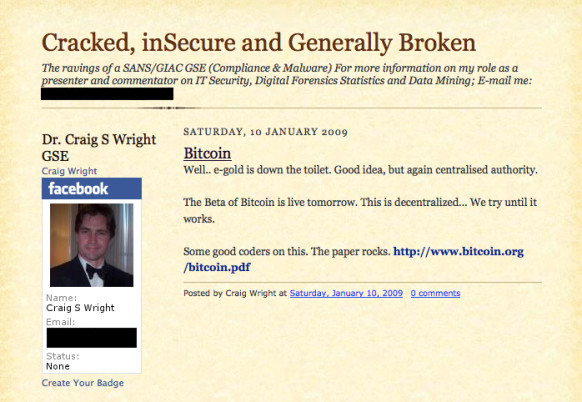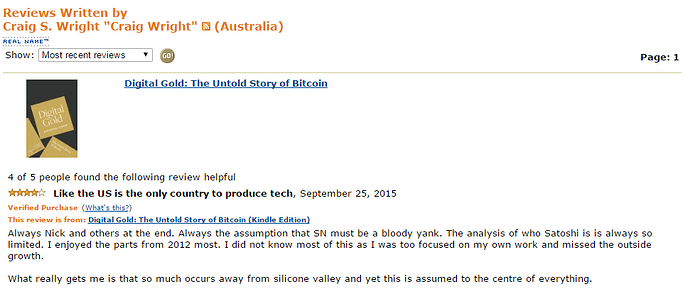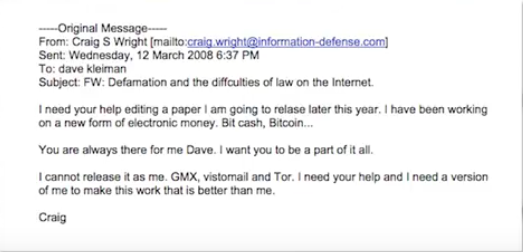¿Quién es Satoshi?
Craig Steven Right,
quien nunca había sido planteado cómo posible, es el sospechoso de ser Satoshi Nakamoto.
Bastante extenso, pero de momento se le da legitimidad al tema, a ver que descubre la gente, porque ya en Reddit hay mucha gente buscando…
Viniendo de WIRED, y con lo sensacionalistas que son, hay que ser prudentes aun, pero al menos los indicios son interesantes, no cómo el Newsweekgate.
https://www.linkedin.com/in/craigswright
En este vídeo habla bastante y sale debatiendo con Nick Szabo este mes pasado:
The Evidence
The first evidence pointing to Wright appeared in mid-November, when an anonymous source close to Wright began leaking documents to Gwern Branwen, a pseudonymous, independent security researcher and dark web analyst. Branwen provided those documents to WIRED, and they immediately led to several direct, publicly visible connections between Nakamoto and Wright:
An August 2008 post on Wright’s blog, months before the November 2008 introduction of the bitcoin whitepaper on a cryptography mailing list. It mentions his intention to release a “cryptocurrency paper,” and references “triple entry accounting,” the title of a 2005 paper by financial cryptographer Ian Grigg that outlines several bitcoin-like ideas.
A post on the same blog from November, 2008. It includes a request that readers who want to get in touch encrypt their messages to him using a PGP public key apparently linked to Satoshi Nakamoto. A PGP key is a unique string of characters that allows a user of that encryption software to receive encrypted messages. This one, when checked against the database of the MIT server where it was stored, is associated with the email address satoshin@vistomail.com, an email address very similar to the satoshi@vistomail.com address Nakamoto used to send the whitepaper introducing bitcoin to a cryptography mailing list.
An archived copy of a now-deleted blog post from Wright dated January 10, 2009, which reads: “The Beta of Bitcoin is live tomorrow. This is decentralized… We try until it works.” (The post was dated January 10, 2009, a day after Bitcoin’s official launch on January 9th of that year. But if Wright, living in Eastern Australia, posted it after midnight his time on the night of the 9th, that would have still been before bitcoin’s launch at 3pm EST on the 9th.) That post was later replaced with the rather cryptic text “Bitcoin – AKA bloody nosey you be…It does always surprise me how at times the best place to hide [is] right in the open.” Sometime after October of this year, it was deleted entirely.

In addition to those three blog posts, we received a cache of leaked emails, transcripts, and accounting forms that corroborate the link. There’s a leaked message from Wright to his lawyer date June 2008 in which Wright imagines “a P2P distributed ledger”—an apparent reference to bitcoin’s public record of transactions known as the blockchain, long before it was publicly released. The email goes on to reference a paper called “Electronic Cash Without a Trusted Third Party” that Wright expects to release in 2009.
Another leaked email from Wright to computer forensics analyst David Kleiman, a close friend and confidant, just before bitcoin’s January 2009 launch discusses a paper they’d been working on together. Wright talks about taking a buyout from his job and investing in hundreds of computer processors to “get [his] idea going.” There’s also a PDF authored by Kleiman, who died in April of 2013, in which he agrees to take control of a trust fund, codenamed the “Tulip Trust,” containing 1.1 million bitcoins. The PDF is signed with Kleiman’s PGP signature, a cryptographic technique that ensures it couldn’t have been altered post-signature.
That million-coin trove—The Tulip Trust—is the same size as a mysterious bitcoin fortune that’s long been visible on bitcoin’s blockchain and widely attributed to Satoshi Nakamoto. No one but Nakamoto is known to have assembled such a massive hoard of the cryptocurrency, and only Nakamoto could have generated so many bitcoins so early in its evolution, when a bitcoin could be “mined” with relatively small amounts of processing power. Only one such bitcoin megapile exists, and the closely-watched coins haven’t moved in bitcoin’s entire history.
Another clue as to Wright’s bitcoin fortune wasn’t leaked to WIRED but instead remains hosted on the website of the corporate advisory firm McGrathNicol: a liquidation report on one of several companies Wright founded known as Hotwire, an attempt to create a bitcoin-based bank. It shows that the startup was backed in June 2013 by $23 million in bitcoins owned by Wright. That sum would be worth more than $60 million today. At the time of the company’s incorporation, Wright’s investment in that one firm alone represented more than 1.5 percent of all existing bitcoins, a strangely large stash for an unknown player in the bitcoin world.
The giveaways go on: There’s a leaked email from Wright to an associate in January 2014 about a tax dispute with the Australian government. In it, he seems to consider using Nakamoto’s name to wield influence with New South Wales Senator Arthur Sinodinos “Would our Japanese friend have weight coming out of retirement?” Wright asks. It includes a draft email to the senator signed “Satoshi Nakamoto.” And a leaked transcript of Wright’s meeting with attorneys and tax officials in February 2014 quotes him in a moment of exasperation: “I did my best to try and hide the fact that I’ve been running bitcoin since 2009,” Wright says. “By the end of this I think half the world is going to bloody know.”**
In a May 2013 blog post titled “Morning Manifesto,” Craig proclaims to himself and the world:
I will make a solution to problems you have not even thought of and I will do it without YOUR or any state’s permission! I will create things that make your ideas fail as I will not refuse to stop producing. I will not live off or accept welfare and I will not offer you violence. You will have to use violence against me to make me stop however.







